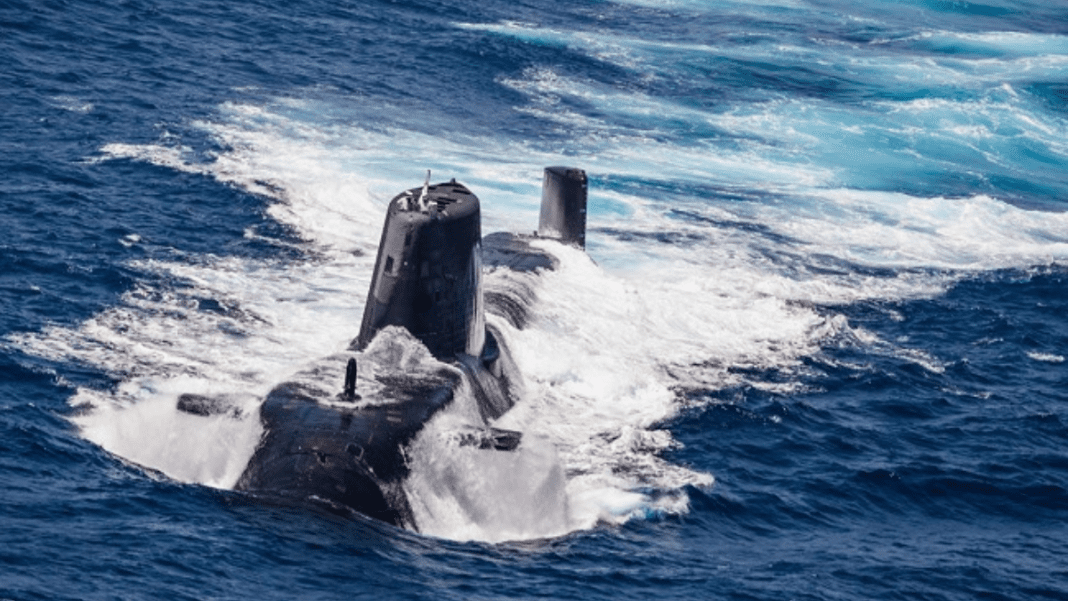Indonesia has reached an exciting new milestone in its naval technology program with a successful torpedo launch from its first autonomous submarine. The unmanned vessel, called KSOT (Kapal Selam Otomatis Tanpa Awak), completed a real-world torpedo firing test that demonstrated how far the country has come in developing advanced underwater machines.
A Major Leap for Indonesia’s Torpedo and Underwater Defense Tech
The test happened near the Fleet Command II Headquarters in Surabaya, East Java. Before the sea trial started, a mobile crane lifted a 324 mm lightweight “Piranha” torpedo and carefully placed it into the KSOT submarine’s starboard-side launch tube. The loading was done at the Navy’s 2nd Fleet Command pier, where teams prepared the autonomous vessel for its mission.
After preparations were complete, the KSOT moved into deeper waters to begin its maneuvers. The unmanned submarine positioned itself accurately using its onboard systems and aligned perfectly for the launch.
With a precise and controlled release, the KSOT fired the torpedo smoothly and successfully. The test proved that the autonomous submarine can carry out tasks usually performed by crewed submarines, marking a major step in Indonesia’s push to strengthen and modernize its naval capabilities.
How the Torpedo-Ready KSOT Works and What Makes It Special
The KSOT is a prototype submarine measuring 15 meters in length and 2.2 meters in width. Despite its compact size, it is built to handle serious underwater missions. It can dive as deep as 350 meters below the surface and travel at speeds of up to 20 knots. These features make it suitable for operations that require stealth and precision.
During the sea trial, the KSOT stayed mostly just below the surface, which helped observers track its actions. Even so, the submarine also completed a diving demonstration to highlight its low-noise and low-visibility features. These capabilities are important for missions that require secrecy, such as patrol operations or underwater surveillance.
The submarine carries advanced equipment, including a sonar system for detecting underwater objects and a launch mechanism designed for lightweight torpedo deployment. These tools help the KSOT perform precision tasks even at great depths. Engineers created the system to work without a crew, which reduces risk during dangerous missions involving underwater weapons such as torpedoes.
📉 Indonesia targeted! Washington unleashes 19% tariff amid sudden shift in global trade playbook
PT PAL Indonesia, a state-owned shipbuilding company known for producing naval ships and equipment, developed the vessel to support and strengthen Indonesia’s current fleet of crewed submarines. With the KSOT in operation, the Navy now has a tool that can perform long-duration missions without needing human operators onboard, including missions that require torpedo launches.
The Navy has announced plans to add 30 autonomous submarines like the KSOT by 2026. With more unmanned vessels, the country can expand its ability to protect territorial waters, monitor remote areas, and respond quickly to threats at sea.
A Milestone Event for Indonesia’s Growing Naval Strength
The recent sea trial was observed closely by defense officials, while national leaders monitored the mission remotely. Their involvement shows the importance of the KSOT program and the country’s focus on strengthening domestic defense technology.
PT PAL shared that the test confirmed significant progress in developing homegrown autonomous systems. According to the company, the firing exercise proved that the submarine’s torpedo launch system works effectively under real mission conditions. This success also reflects years of research aimed at creating strong tools that can protect the nation’s waters.
The KSOT was first introduced to the public during the 80th anniversary parade of the Indonesian National Armed Forces in October. At the event, the submarine drew attention because it represented a new era of underwater defense tools. Its autonomous control, stealth features, and torpedo-launch capability offered a clear picture of how future missions might become more efficient and safer.
Indonesia stuns China with bold Rafale jet surge during Paris defense push
During the sea trial, the submarine’s modern sensors, quiet operation, and underwater maneuvering showed that it could handle a wide range of tasks. These missions may include underwater patrols, surveillance, or precision strike activities using torpedoes. Although the KSOT is still a prototype, the results show that it is already capable of meaningful operational duties.
PT PAL continues to test and refine the KSOT to improve its performance. Engineers are studying how well the submarine works with other naval units and how its torpedo system performs under different conditions. As evaluations continue, the submarine’s systems and features will be further improved to meet real-world defense needs.
The successful firing of the torpedo marks a major step forward in Indonesia’s underwater defense capability. The KSOT’s performance highlights the strength of local engineering and showcases the nation’s expanding role in advanced maritime technology.
